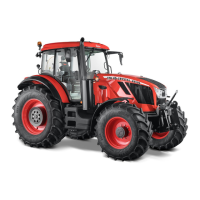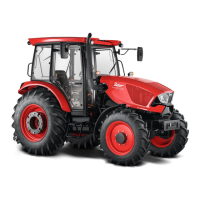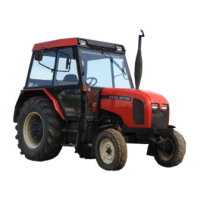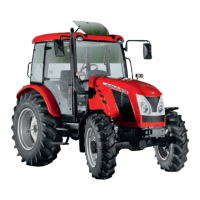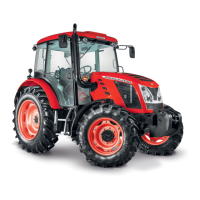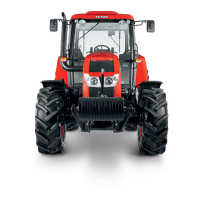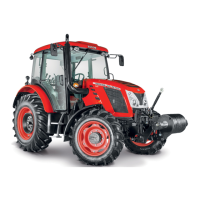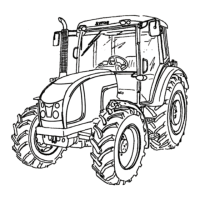Do you have a question about the Zetor CRYSTAL Series and is the answer not in the manual?
| Transmission | Mechanical or PowerShift |
|---|---|
| Aspiration | Turbocharged |
| Hydraulic System | Load Sensing (LS) |
| Cylinders | 6 |
| Hydraulic System Type | Load Sensing (LS) |
| PTO Speed | 540/1000 rpm |
| Weight Approx | 3, 800-5, 500 kg |
General rules for tractor operation and user conduct, including driving license and acquaintance with rules.
Recommendations for appropriate attire and personal protective equipment to ensure operator safety.
Instructions and warnings related to safely starting the tractor's engine.
Guidelines and prohibitions for operating the tractor safely, including slopes and ground conditions.
Rules regarding the transport of passengers and safe operation with attached implements.
Safety procedures for recovering a stuck tractor using tow bars or ropes.
Steps for safely exiting and securing the tractor before leaving it unattended.
Measures to prevent fires, including safe refueling and handling of flammable materials.
Information on handling tractor fluids safely and procedures for environmental disposal.
Precautions and proper handling procedures for the tractor's air conditioning system.
Warnings regarding modifications and safe handling of the tractor's electrical system.
Rules and restrictions for using the front passenger seat during operation or transport.
Information on external/internal noise and driver's seat vibration levels and protection.
Safety requirements and usage guidelines specific to tractors fitted with front end loaders.
Checking the fuel system, including the tank, for any leaks and immediate repair.
Procedure for checking and maintaining the engine oil level between the dipstick marks.
Inspection of the cooling system for leaks and ensuring coolant level is within limits.
Checking the liquid brakes for leaks and maintaining the brake fluid level in the expansion tank.
Checking the air system of the brakes for leaks and the efficiency of brakes with a trailer.
Checking the tightening of steering rods/levers and condition of hydraulic steering hoses.
Checking and cleaning the air cleaner, including clog detection and filter replacement.
Checking and cleaning cab ventilation air filters installed in the roof overhang.
Checking the condition of the hitching and attachment systems of the tractor and trailer.
Checking hydraulic circuits after front implement work and cleaning coolers if clogged.
Checking air pressure in tyres and retightening wheel bolts if necessary.
Verifying dashboard signal lamps and hydraulic control circuits after engine start.
Information regarding the tractor's safety cabin, including door operation and glass.
Instructions on how to open the tractor doors from both the outside and inside.
Operation and safety advice for the rear and side windows.
Operation of the hinged lid and adjustment of the swing lid screen and cover.
Location and description of the storage shelves within the tractor cabin.
Guidance on adjusting rear view mirrors for optimal visibility.
Instructions on how to turn the internal cabin lights on and off.
Purpose and use of the aggregation opening for tool controls.
Detailed explanation of driver's seat adjustments for suspension and position.
Instructions on how to adjust and tilt the passenger's seat.
Descriptions of control panels located on the cabin column and rear mudguard.
Explanation of the layout and components of the instrument panel.
Operation of various lighting switches, including direction lights and warning lights.
Description of the key switch box and its different positions (0, I, II).
How to adjust the steering wheel's tilt and protrusion for comfort.
Explanation of how to use the manual throttle lever to set engine revolutions.
Operation of the reversing lever and the main gear shifting lever.
Identification and purpose of the tractor's pedals.
Operation of the levers for selecting road and reduced speeds.
Control for preselecting PTO shaft revolutions.
Controls for the manual brake and semi-trailer coupling.
Function and location of the battery disconnector switch.
Description of the control panel for cabin heating and air conditioning.
Guidance on operating fan speed, air conditioning, and circulation controls.
Procedures for quickly heating or cooling the cabin area.
Recommendations for using heating and air conditioning during tractor work.
Information on positionable registers for air flow control.
Using vents for quick and effective defrosting of the front windshield.
Use and maintenance instructions for active carbon air filters.
Operation of the front window wiper and washer system.
Adjusting the speed and interval of the front wiper.
Operation of the rear window wiper.
Location and capacity of the windshield washer fluid tank.
Description of the fuel tank, its capacity, and safety warnings.
Description of the urea tank, its capacity, and important handling warnings.
Explanation of the function of each warning and indicator lamp on the instrument panel.
Description of the gauges and displays on the instrument panel.
Explanation of the functions of the buttons used for navigating the dashboard.
Overview of the values displayed on the main screen and how to change the display layout.
How to click between individual data displays (screens) on the dashboard.
Procedures for manually resetting trip data and service interval indicators.
Warning indicator on the display when the manual brake is not engaged.
Information on approaching maintenance alerts and exceeding service intervals.
Steps to reset the indicator of service inspection intervals after maintenance.
How the tractor signals errors and interpretation of error messages.
Explanation of symbols used to represent tractor components in error messages.
How to enter and navigate the tractor's service menu.
Accessing past error logs and changing the display language.
Information on displaying and recording the machined area.
Navigating the machined area menu and setting the working width.
How to start, end, and manage records of the machined area.
Accessing calibration menus for various tractor functions.
Detailed procedure for calibrating the tractor's travel speed.
Procedure for calibrating the steering sensors of the front axle.
Instructions for adjusting the tractor's internal clock.
Warnings related to fuel level and other critical indicators on the dashboard.
Indication and handling of high and low coolant temperature warnings.
Indication and handling of high engine oil temperature warnings.
Warnings for water in fuel filter and high air intake temperature.
Warnings for high gearbox oil temperature and fuel filter issues.
Explanation of the Selective Catalytic Reduction (SCR) system for emission control.
Requirements for the SCR system to function correctly, including temperature and engine RPM.
Details about urea solution, its properties, storage, and safe handling principles.
How SCR system errors or low urea levels affect engine power and revolutions.
How the amount of urea in the tank is displayed and indicated.
Procedures for draining urea and replacing the filter element during long shutdowns.
Pre-operation checks including braking, gear selection, and PTO status.
Step-by-step guide for starting the tractor engine safely and correctly.
Advice on engine warming procedures and the importance of proper idling after starting.
How errors are indicated and how system faults affect engine power.
Operation of the gear shifting lever, reversing lever, and their display signals.
Selecting road/reduced speeds and the function of the driver's seat safety switch.
Description and comparison of different methods for controlling the travel clutch.
Methods for starting the tractor from a standstill using clutch pedal or automatic function.
Procedures for changing the tractor's direction of travel using the reversing lever or clutch pedal.
Techniques for shifting gears during travel using clutch pedal or control button.
Operation of the three-gear torque multiplier, including preselection and automatic shifting.
Controls and modes for engaging the front drive axle, including manual and automatic operation.
Operation of manual and automatic axle lock controls for rear and front axles.
Information on tractors equipped with suspension front drive axle and its settings.
Description of foot brakes, trailer brakes, and air pressure systems.
Procedures for stopping the tractor, shutting down the engine, and safely leaving the cab.
Indication and meaning of warnings related to hydrostatic steering system failure.
Function that automatically reduces engine revolutions when exceeding the travel speed limit.
Guidelines for operating a new tractor during the first 100 hours, including load and checks.
Specific procedures for performing run-in in traffic during the initial 10 hours.
Instructions for operating the tractor without limitations after the initial run-in period.
Description and operation of the CBM stage quick-adjusting hitch.
How to adjust the height and disassemble the CBM stage hitch.
Functionality and operation of the automatic hitch mouth.
Overview of modular hitch systems for trailers and semi-trailers.
Description and disassembly of the swinging draw-bar console module.
Description of the console with a Ø 80 ball hitch for semi-trailers.
Specific hitch requirements for single-axle semi-trailers.
Specifications for maximum permissible vertical static load for various hitch types.
Safe procedures for attaching and operating implements driven by the PTO shaft.
How to engage and control the front and rear PTO shafts using cabin switches.
Control lever for selecting rear PTO shaft revolutions.
Operation of standard/economical independent rear PTO shaft revolutions.
Understanding dependent vs. independent rear PTO shaft revolutions.
Using a button to facilitate connecting the joint shaft of aggregated machinery.
Switch for selecting rear PTO shaft clutch revolutions (540 rpm or 1000 rpm).
Procedure for replacing the PTO shaft end points.
How to engage and disengage the rear PTO shaft clutch.
Steps for engaging the rear PTO shaft with independent revolutions.
Steps for engaging the rear PTO shaft with dependent revolutions.
Functionality and operation of the automatic PTO clutch disengagement feature.
How to configure automatic PTO clutch disengagement settings.
Operating the tractor with the automatic PTO clutch disengagement feature.
Procedures for starting, stopping, and restarting the rear PTO shaft.
Description of the front PTO shaft, its design, and direction of rotation.
How to engage and control the front PTO shaft.
Power output specifications for front and rear PTO shafts.
Safety precautions for driving machines with high inertia masses using the PTO.
General description of the tractor's hydraulic system, including oil source.
Description of the hydraulic pump, its operation, and pressure limitations.
Location of control panels for hydraulic and electro-hydraulic systems.
Function of the outer circuit supplying oil to implements via quick-couplers.
Safe practices for connecting and disconnecting quick-couplers, including oil handling.
Optional system for collecting leakage oil from quick-couplings.
How the hydraulic distributor controls oil flow to different sections and levers.
Description of rear hydraulic outlets and their connection types.
Description of front hydraulic outlets and their connection to adapters.
How to connect agricultural machines and implements to the outer hydraulic circuit.
Description of the functions of electro-hydraulic control elements like lifting switch and LEDs.
How to deactivate the electro-hydraulic system via the switch box.
Steps to cancel the electronic blocking of the lifting device and activate the EHR-B system.
Operation of the quick sinking function for the three-point hitch.
Securing implements during transport using the hitch and safety latch.
How to immediately stop the movement of the three-point hitch.
Function and advantages of the vibration compensator for heavy implements.
How to limit the upper position of the three-point hitch using control (5).
Adjusting the lowering speed of the three-point hitch using control (3).
Using the free position for permanent work with the hydraulic system.
Two ways to control the three-point hitch: manual and automatic (HitchTronic).
Detailed steps for manually setting and controlling the three-point hitch.
Procedure for setting up and using the automatic three-point hitch control.
Operation of the three-point hitch using external controls on the tractor fenders.
Functionality of external buttons for hitch control, even with system blockage.
How EHR-B system errors are indicated via diagnostic LED flashing.
Interpretation of EHR-B error signals based on diagnostic LED flashing patterns.
Troubleshooting guide for minor errors in the EHR-B electro-hydraulic system.
Description and specifications of the rear three-point hitch, ISO category III.
Critical safety advice for working with the three-point hitch and attached implements.
Procedure for adjusting the height of the lifting draw-bars.
Understanding fixed and free positions for the lower hydraulic draw-bars.
Function and adjustment of limiting draw-bars (stabilizers) to prevent lateral swing.
Operation of automatic limiting draw-bars for length adjustment and floating position.
Details on lower draw-bars equipped with CBM hooks for implement attachment.
How to securely lock lower draw-bar hooks using an M8 screw.
Description and adjustment of the upper draw-bar's length.
Description of the front three-point hitch system for agricultural machinery.
Adjusting the lowering speed of the front three-point hitch.
How to operate the front three-point hitch using its integrated hydraulic distributor.
How to hydraulically lock the front three-point hitch for safety.
Understanding working and transport positions for the front three-point hitch.
Safety advice for driving with agricultural machines attached to the front three-point hitch.
Front wheel track for tractors with non-removable discs and toe-in measurement.
Adjusting the toe-in of front wheels based on drive axle type and tractor height.
Toe-in specifications for solid and suspension front drive axles.
Step-by-step procedure for adjusting front wheel toe-in.
Information on front drive axle fender designs and adjustment.
Checking and setting wheel stops for the front drive axle after track or tire changes.
Information regarding the wheel track width for rear wheels.
Information and combinations for rear wheel counterweights.
Description and installation details for bottom weights.
Information and combinations for front counterweights, including towing hook use.
Specifications for the weight of the front three-point hitch.
Procedure for filling tractor tires with liquid ballast using a valve.
Warnings regarding the prohibition of liquid ballast in front tires.
Steps for safely draining liquid ballast from tractor tires.
Details on preparing antifreeze solutions for tire filling and safety precautions.
General information on connecting the battery, alternator, and avoiding short-circuits.
Description and location of the accumulator battery, accessible after folding the cab step.
Function and location of the battery disconnector for parking or maintenance.
How to maintain the accumulator battery, including adding distilled water and safety precautions.
Description of the alternator and procedures for its maintenance and overload conditions.
Location of the fuse panel and identification of individual fuses and their ratings.
Procedures for checking and adjusting front grill and cab roof headlights.
Table detailing lamp locations, voltage, power, and type for the tractor.
Daily checklist of items to inspect before starting tractor operation.
Checks to perform before starting the engine, including fluid levels and connections.
Checks to perform after starting the engine, focusing on indicators and functions.
Maintenance tasks scheduled at 50, 100, 500-hour intervals, and other time-based checks.
Procedures for changing engine oil, filters, and other operational fluids.
Table listing required operation liquids, their capacities, and specifications.
List of recommended oils and fluids for various tractor systems.
Specifications and replacement guidelines for hydraulic brake fluid.
Coolant specifications, mixing ratios, and replacement intervals.
Information on fuel type requirements and urea solution (AUS 32) specifications.
Details on tractor greasing schemes, including transmission shaft and drive axles.
Greasing points for the front three-point hitch, three-point hitch, and hitch mouth.
Maintenance procedures for tractors after a general overhaul of main groups.
Step-by-step instructions for opening and closing the tractor hood safely.
Procedure for daily check of engine oil level using the dipstick.
Steps for safely draining engine oil when the engine is warm.
Procedure for refilling the engine with the correct amount of oil.
Instructions for replacing the full-continuous motor oil filter element.
Description of the two-stage fuel filtering system.
Procedure for clearing the raw fuel filter, including draining and tightening.
Steps for replacing the raw fuel filter cartridge, including sensor disconnection.
Instructions for replacing the fine fuel filter cartridge.
Procedure for venting the fuel system after filter replacement.
Instructions for dry air cleaner maintenance, including element recovery and replacement.
Procedure for bleeding air from the hydraulic circuit of the hydrostatic steering.
Guidelines for replacing hydrostatic steering hoses based on age or damage.
Step-by-step procedure for replacing the engine coolant.
How to check the oil level in the gearbox and final drive housing.
Procedures for checking and replacing oil in the gearbox and drive housing.
Replacing the transmission oil cleaner element with hydraulic pump suction filter.
Procedure for replacing the filter element of the urea filter.
Lubrication and filling points for the front driving axle (suspension and solid).
Filling, inspection, and draining of oil for front wheel reducers.
Inspection and filling of oil for the front PTO.
Procedure for replacing brake fluid, emphasizing cleanliness.
Instructions for installing carbon filters into the air duct.
Instructions for cleaning heating system filters located under cabin grills.
Use and maintenance of active carbon filters for cabin air.
Maintenance of the air conditioning system, focusing on cleaning the cooler.
Procedure for draining condensate from the air reservoirs.
Testing air systems for leaks by filling reservoirs to maximum pressure.
Air pressure specifications for single and double-hose brake systems.
General tyre maintenance, verification for defects, and recommended inflation pressures.
Recommended inflation values for rear wheel tires based on type and activity.
Information on load-bearing capacity and inflation for diagonal and radial driving tires.
Procedures for storing the tractor for short or long periods, including tire pressure.
Valve clearance adjustment must be performed by authorized service.
The flat belt drive tension for accessories does not require adjustment as it is automatic.
Procedure for adjusting the proper play between brake pedal and master cylinder.
Steps for bleeding air from the hydraulic brake system of the tractor.
Specific procedure for bleeding the rear brake system to remove air bubbles.
How to check the foot brake system for proper operation and pedal depression.
Procedure for adjusting the foot brake system for proper braking effect.
Procedure for adjusting the parking brake to ensure proper braking effect.
Adjusting lifting draw-bars of the hitch for a single-axle semi-trailer.
Adjusting the Bowden cable to eliminate play in the control lever.
Key dimensions and measurements of the tractor, including length and height.
Specifications for the tractor's engine, including type, capacity, and performance data.
Permitted maximum load limits for the front and rear axles in kilograms.
Permitted maximum weight for the tractor combined with mounted machinery.
Information regarding tractor maneuverability based on speed and front axle load.
Data on front tire steerability, load capacity, and inflation pressure.
How the load-bearing capacity of front tires changes with speed.
Data on rear tire load capacity and inflation values.
How the load-bearing capacity of rear tires changes with speed.
Allowed combinations of front and rear wheel dimensions for tractors.
Power output specifications for the rear PTO shaft.
Specifications for the lifting force of the rear and front three-point hitches.
Information on the tractor's tensile force capabilities.
Charts showing tractor speed based on engine RPM, gear, and tire size.
Charts detailing PTO shaft revolutions relative to engine RPM for dependent and independent modes.
Specifications for the Zuidberg front PTO speed and engine RPM.
Dimensions related to the tractor's turning circle and clearance.

